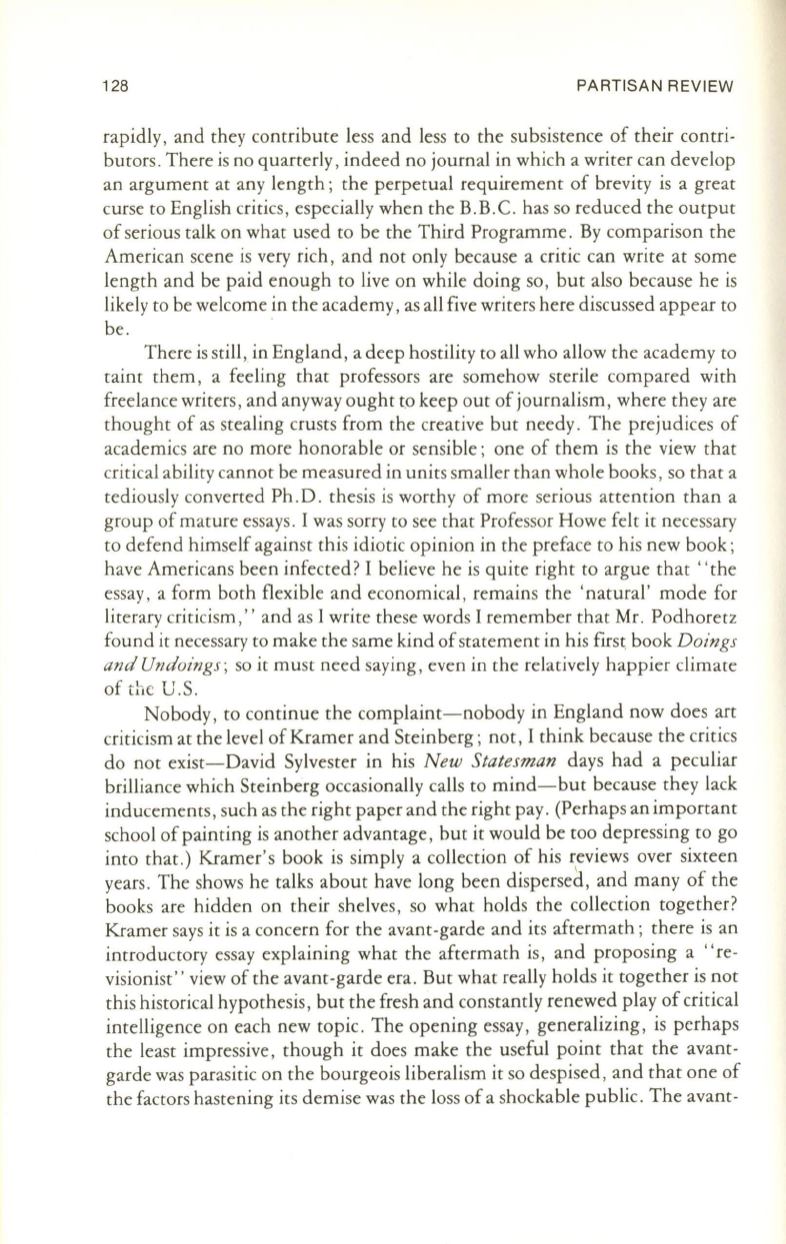
128
PARTISAN REVIEW
rapidly , and they contribute less and less to the subsistence of their contri–
butors . There is no quarterly , indeed no journal in which a writer can develop
an argument at any length; the perpetual requirement of brevity is a great
curse to English critics , especially when the B.B.C. has so reduced the output
of serious talk on what used to be the Third Programme . By comparison the
American scene is very rich, and not only because a critic can write at some
length and be paid enough to live on while doing so , but also because he is
likely to be welcome in the academy, as all five writers here discussed appear to
be.
.
There is still, in England, a deep hostility to all who allow the academy to
taint them , a feeling that professors are somehow sterile compared with
freelance writers, and anyway ought t.o keep out of journalism, where they are
thought of as stealing crusts from the creative but needy. The prejudices of
academics are no more honorable or sensible ; one of them is the view that
critical ability cannot be measured in units smaller than whole books , so that a
tediously converted Ph.D . thesis is worthy of more serious attention than a
group of mature essays. I was sorry to
see
that Professor Howe felt it necessary
to defend himself against this idiotic opinion in the preface to his new book ;
have Americans been infected?
I
believe he is quite right to argue that ' ' the
essay , a form both flexible and economical , remains the ' natural' mode for
literary criticism ," and as
I
write these words
I
remem
ber that Mr. Podhoretz
found it necessary to make the same kind ofstatement in his
firs~
book
Doings
and Undoings;
so it must need saying, even in the relatively happier climate
ofttlc U.S.
Nobody , to continue the complaint-nobody in England now does art
criticism at the level of Kramer and Steinberg ; not, I think because the critics
do not exist-David Sylvester in his
New Statesman
days had a peculiar
brilliance which Steinberg occasionally calls to mind-but because they lack
inducements, such as the right paper and the right pay. (Perhaps an important
school of painting is another advantage, but it would be too depressing to go
into that.) Kramer's book is simply a collection of his reviews over sixteen
years. The shows he talks about have long been dispersed, and many of the
books are hidden on their shelves, so what holds the collection together?
Kramer says it is a concern for the avant-garde and its aftermath; there is an
introductory essay explaining what the aftermath is , and proposing a "re–
visionist" view of the avant-garde era. But what really holds it together is not
this historical hypothesis, but the fresh and constantly renewed play of critical
intelligence on each new topic. The opening essay, generalizing , is perhaps
the least impressive , though it does make the
useful
point that the avant–
garde was parasitic on the bourgeois liberalism it so despised , and that one of
the factors hastening its demise was the loss of a shockable public. The avant-


